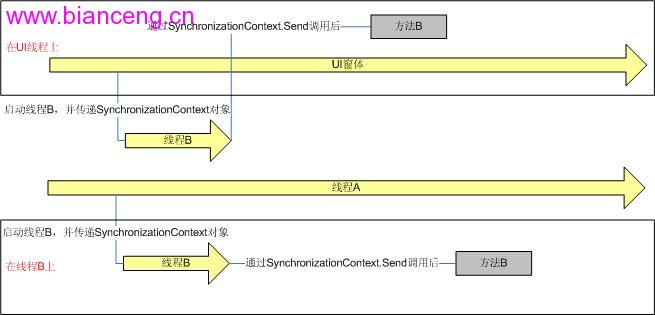上一篇中已經講了SynchronizationContext 的一些內容,現在讓我們更加深入地去了解它!
繼上篇中的問題"在UI線程上對SynchronizationContext的使用,可以適用於其他線程呢?"
OK,我們把它放置在非UI線程上,這是你用SynchronizationContext.Current的屬性來獲取,你會發 現你得到的是null,這時候,你可能會說,既然它不存在,那麼我自己創建一個SynchronizationContext 對象,這樣就沒問題了吧!?可是,最後它並不會像UI線程中那樣去工作。
讓我們看下面的例子:
class Program
{
private static SynchronizationContext mT1 = null;
static void Main(string[] args)
{
// log the thread id
int id = Thread.CurrentThread.ManagedThreadId;
Console.WriteLine("Main thread is " + id);
// create a sync context for this thread
var context = new SynchronizationContext();
// set this context for this thread.
SynchronizationContext.SetSynchronizationContext(context);
// create a thread, and pass it the main sync context.
Thread t1 = new Thread(new ParameterizedThreadStart(Run1));
t1.Start(SynchronizationContext.Current);
Console.ReadLine();
}
static private void Run1(object state)
{
int id = Thread.CurrentThread.ManagedThreadId;
Console.WriteLine("Run1 Thread ID: " + id);
// grab the sync context that main has set
var context = state as SynchronizationContext;
// call the sync context of main, expecting
// the following code to run on the main thread
// but it will not.
context.Send(DoWork, null);
while (true)
Thread.Sleep(10000000);
}
static void DoWork(object state)
{
int id = Thread.CurrentThread.ManagedThreadId;
Console.WriteLine("DoWork Thread ID:" + id);
}
}
輸出的結果:
Main thread is 10 Run1 Thread ID: 11 DoWork Thread ID:11
注意上面的輸出結果,DoWork和Run1是運行在同一線程中的,SynchronizationContext並沒有把 DoWork帶入到主線程中執行,為什麼呢?!
我們可以先看SynchronizationContext的原碼(SynchronizationContext原代碼):
namespace System.Threading
{
using Microsoft.Win32.SafeHandles;
using System.Security.Permissions;
using System.Runtime.InteropServices;
using System.Runtime.CompilerServices;
using System.Runtime.ConstrainedExecution;
using System.Reflection;
internal struct SynchronizationContextSwitcher : IDisposable
{
internal SynchronizationContext savedSC;
internal SynchronizationContext currSC;
internal ExecutionContext _ec;
public override bool Equals(Object obj)
{
if (obj == null || !(obj is SynchronizationContextSwitcher))
return false;
SynchronizationContextSwitcher sw = (SynchronizationContextSwitcher)obj;
return (this.savedSC == sw.savedSC &&
this.currSC == sw.currSC && this._ec == sw._ec);
}
public override int GetHashCode()
{
return ToString().GetHashCode();
}
public static bool operator ==(SynchronizationContextSwitcher c1,
SynchronizationContextSwitcher c2)
{
return c1.Equals(c2);
}
public static bool operator !=(SynchronizationContextSwitcher c1,
SynchronizationContextSwitcher c2)
{
return !c1.Equals(c2);
}
void IDisposable.Dispose()
{
Undo();
}
internal bool UndoNoThrow()
{
if (_ec == null)
{
return true;
}
try
{
Undo();
}
catch
{
return false;
}
return true;
}
public void Undo()
{
if (_ec == null)
{
return;
}
ExecutionContext executionContext =
Thread.CurrentThread.GetExecutionContextNoCreate();
if (_ec != executionContext)
{
throw new InvalidOperationException(Environment.GetResourceString(
"InvalidOperation_SwitcherCtxMismatch"));
}
if (currSC != _ec.SynchronizationContext)
{
throw new InvalidOperationException(Environment.GetResourceString(
"InvalidOperation_SwitcherCtxMismatch"));
}
BCLDebug.Assert(executionContext != null, " ExecutionContext can't be
null");
// restore the Saved Sync context as current
executionContext.SynchronizationContext = savedSC;
// can't reuse this anymore
_ec = null;
}
}
public delegate void SendOrPostCallback(Object state);
[Flags]
enum SynchronizationContextProperties
{
None = 0,
RequireWaitNotification = 0x1
};
public class SynchronizationContext
{
SynchronizationContextProperties _props = SynchronizationContextProperties.None;
public SynchronizationContext()
{
}
// protected so that only the derived sync
// context class can enable these flags
protected void SetWaitNotificationRequired()
{
// Prepare the method so that it can be called
// in a reliable fashion when a wait is needed.
// This will obviously only make the Wait reliable
// if the Wait method is itself reliable. The only thing
// preparing the method here does is to ensure there
// is no failure point before the method execution begins.
RuntimeHelpers.PrepareDelegate(new WaitDelegate(this.Wait));
_props |= SynchronizationContextProperties.RequireWaitNotification;
}
public bool IsWaitNotificationRequired()
{
return ((_props &
SynchronizationContextProperties.RequireWaitNotification) != 0);
}
public virtual void Send(SendOrPostCallback d, Object state)
{
d(state);
}
public virtual void Post(SendOrPostCallback d, Object state)
{
ThreadPool.QueueUserWorkItem(new WaitCallback(d), state);
}
public virtual void OperationStarted()
{
}
public virtual void OperationCompleted()
{
}
// Method called when the CLR does a wait operation
public virtual int Wait(IntPtr[] waitHandles,
bool waitAll, int millisecondsTimeout)
{
return WaitHelper(waitHandles, waitAll, millisecondsTimeout);
}
// Static helper to which the above method
// can delegate to in order to get the default
// COM behavior.
protected static extern int WaitHelper(IntPtr[] waitHandles,
bool waitAll, int millisecondsTimeout);
// set SynchronizationContext on the current thread
public static void SetSynchronizationContext(SynchronizationContext syncContext)
{
SetSynchronizationContext(syncContext,
Thread.CurrentThread.ExecutionContext.SynchronizationContext);
}
internal static SynchronizationContextSwitcher
SetSynchronizationContext(SynchronizationContext syncContext,
SynchronizationContext prevSyncContext)
{
// get current execution context
ExecutionContext ec = Thread.CurrentThread.ExecutionContext;
// create a switcher
SynchronizationContextSwitcher scsw = new SynchronizationContextSwitcher();
RuntimeHelpers.PrepareConstrainedRegions();
try
{
// attach the switcher to the exec context
scsw._ec = ec;
// save the current sync context using the passed in value
scsw.savedSC = prevSyncContext;
// save the new sync context also
scsw.currSC = syncContext;
// update the current sync context to the new context
ec.SynchronizationContext = syncContext;
}
catch
{
// Any exception means we just restore the old SyncCtx
scsw.UndoNoThrow(); //No exception will be thrown in this Undo()
throw;
}
// return switcher
return scsw;
}
// Get the current SynchronizationContext on the current thread
public static SynchronizationContext Current
{
get
{
ExecutionContext ec = Thread.CurrentThread.GetExecutionContextNoCreate();
if (ec != null)
return ec.SynchronizationContext;
return null;
}
}
// helper to Clone this SynchronizationContext,
public virtual SynchronizationContext CreateCopy()
{
// the CLR dummy has an empty clone function - no member data
return new SynchronizationContext();
}
private static int InvokeWaitMethodHelper(SynchronizationContext syncContext,
IntPtr[] waitHandles,
bool waitAll,
int millisecondsTimeout)
{
return syncContext.Wait(waitHandles, waitAll, millisecondsTimeout);
}
}
}
注意Send和Post的部分:
public virtual void Send(SendOrPostCallback d, Object state)
{
d(state);
}
public virtual void Post(SendOrPostCallback d, Object state)
{
ThreadPool.QueueUserWorkItem(new WaitCallback(d), state);
}
Send就是簡單在當前的線程上面去調用委托來實現,而Post是通過線程池來實現。
這時候你也許會奇怪,為什麼UI線程上,SynchronizationContext就發揮了不同的作用呢!其實在UI 線程中使用的並不是SynchronizationContext這個類,而是WindowsFormsSynchronizationContext這個東 東。

它重寫了Send和Post方法。至於它是如何重寫實現的,這個我也不是很了解,也沒有找到相關的文章 ,只是知道通過"消息泵"來實現的,但是細節就不清楚了,如果大家知道的話,可以告訴下我,我很想了 解下!呵呵
最後,我畫了一副圖,讓我們更加清楚地了解SynchronizationContext在UI線程和一般線程之間的不 同,
